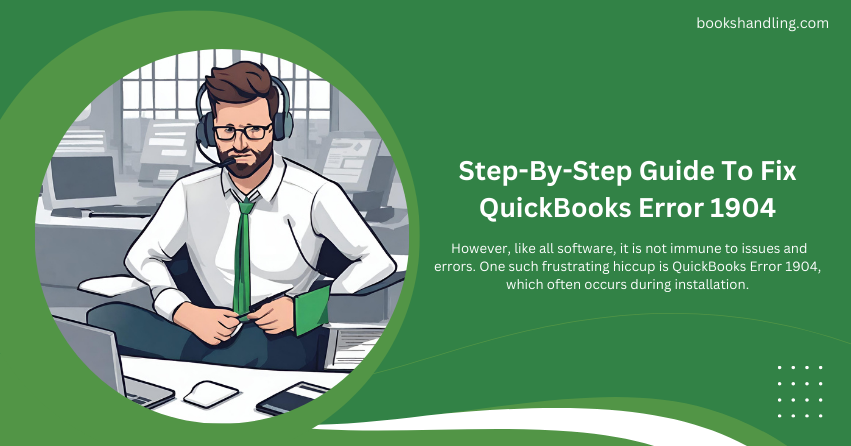
What is QuickBooks Error 1904?
QuickBooks Error 1904 typically manifests when you are installing QuickBooks Desktop software. It is accompanied by the message:
“Error 1904: [file path/name/extension] failed to register.”
This error indicates a failure in the installation process, specifically related to specific files not being able to register with your operating system. This can lead to an incomplete or unsuccessful installation, preventing you from using QuickBooks effectively.
Causes of QuickBooks Error 1904
Understanding the causes behind QuickBooks Error 1904 is crucial for a targeted approach to solving it. Some common reasons include:
- Damaged Microsoft components: QuickBooks relies on Microsoft components like MSXML, Microsoft C++, and .NET Framework. If these components are damaged or outdated, QuickBooks may not install properly.
- Upgraded operating system: If you recently upgraded your operating system, some essential settings might have been reset or are no longer compatible with QuickBooks.
- Security software interference: Sometimes, antivirus or other security software might block specific QuickBooks files from registering during the installation.
- User permissions: Lack of administrative permissions to install software can also trigger this error.
- File integrity issues: Corrupted or missing QuickBooks installation files can lead to Error 1904.
Step-By-Step Guide To Fix QuickBooks Error 1904
Now that we understand the potential triggers let’s walk through the steps to resolve QuickBooks Error 1904. These steps are designed to be user-friendly, even for those who may not be very tech-savvy.
Step 1: Install QuickBooks Install Diagnostic Tool
The QuickBooks Install Diagnostic Tool can automatically resolve many common issues related to Microsoft components and other installation errors.
- Download the QuickBooks Tool Hub: The Tool Hub is a collection of QuickBooks tools in one application. Download it from the Intuit website and save it to your computer.
- Open the file you downloaded (QuickBooksToolHub.exe) and follow the on-screen instructions to install it.
- Open the QuickBooks Tool Hub after installation.
- Navigate to the Installation Issues tab and select the QuickBooks Install Diagnostic Tool. Run the tool.
- Restart your computer after the tool has completed its work to ensure all components are updated correctly.
Step 2: Check Your Permissions
Ensure that the user account you use to install QuickBooks has administrative rights.
- Go to the Control Panel and select User Accounts.
- Check if your user account is listed as an Administrator. If not, log in from an administrator account or change your account type.
Step 3: Manually Fix Windows Components
If the Install Diagnostic Tool does not resolve the issue, you may need to manually repair or reinstall Microsoft components.
- For Microsoft .NET Framework:
- Open the Control Panel and go to Programs and Features.
- Click on Turn Windows features on or off.
- Check if the box next to .NET Framework is ticked. If not, enable it. If it’s enabled, try turning it off, restarting your computer, and turning it back on.
- For Microsoft MSXML and C++:
- Uninstall and reinstall these components from the official Microsoft website.
Step 4: Modify Your Security Software Settings
Temporarily disable your antivirus or security software during QuickBooks installation. Be sure to re-enable it immediately after.
- Open your antivirus control panel.
- Look for a ‘disable’ or ‘turn off’ option and select it briefly.
- Install QuickBooks. Once installed, remember to reactivate your antivirus.
Step 5: Install QuickBooks Using Selective Startup Mode
Sometimes, other applications can interfere with the installation of QuickBooks.
- Open the Run dialog (press Windows + R keys).
- Type msconfig and press Enter.
- Select Selective Startup and Load System Services in the System Configuration Utility.
- Click OK and restart your computer.
- Try installing QuickBooks again.
Step 6: Check File Integrity
Verify that the installation files you are using are complete and not corrupted.
- Download a fresh installer from the QuickBooks website.
- Run the installer to see if the issue persists.
Conclusion
QuickBooks Error 1904 can be a roadblock for many users, but with the right approach, it is entirely manageable. By following this guide, you can address the error comprehensively and get back to managing your business finances efficiently. Remember, it’s essential to maintain regular backups and keep your software up to date to minimize potential issues.
